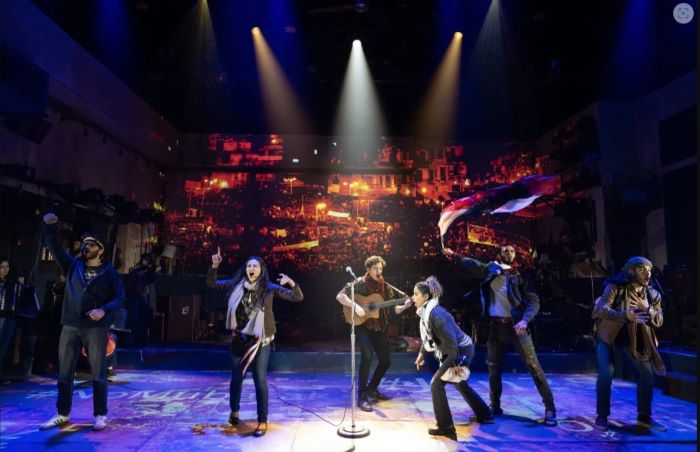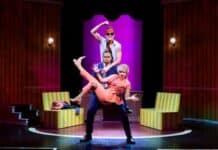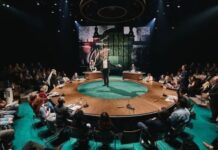In 2011, Egyptian student activists took to the streets of Cairo during the uprising of the Arab Spring to oust the authoritarian regime of President Hosni Mubarak, only to see an escalation in violence and division, and a severe military crackdown in the aftermath of the rebellion. Inspired by the momentous real-life events, the original musical We Live in Cairo, by Lebanese-American brothers Daniel and Patrick Lazour (book, music, and lyrics) and winner of the 2016 Richard Rodgers Award for Musical Theatre, tells the fictionalized story of six young revolutionaries, tracing their impassioned journey from the initial secret planning sessions of 2010, to the public protests in 2011, employing their social media posts, photography, songs, and street art to amass a huge following, to the celebration of the announcement of Mubarak’s resignation after eighteen days of demonstrations in the city’s Tahrir Square, through the struggles they faced, in-fighting within the group, and the high cost of keeping their dreams of change, and themselves, alive in the years that followed.

Under the insightful direction of Taibi Magar, an all-Arab-American six person cast – Rotana Tarabzouni as third-generation political activist Fadwa, who passionately leads the group’s action; Nadina Hassan as photographer Layla, who is at first hesitant to participate for fear of government reprisal; Ali Louis Bourzgui as musician/composer Amir, a Coptic Christian who is dating Layla; Michael Khalid Karadsheh as Amir’s brother and lyricist Hany; John El-Jor as Fadwa’s cousin and graffiti artist/satirist Karim, who uses the tag @KingFarouk; and Drew Elhamalawy as aspiring artist Hassan, who joins the group when his father, a member of the radical fundamentalist Muslim Brotherhood (whose candidate Mohamed Morsi would win the 2012 presidential election and inspire Fadwa to organize more protests), orders him to paint over one of Karim’s murals – captures the distinctive personalities, backgrounds, and motivations of the characters, their interactions, and the changes they undergo as the socio-political situation develops, causing friction and irreparable damage among them, while ultimately paying homage to the brave young activists who stood up and fought for what they believed would better their country and the lives of the people.

The story is told through their compelling conversations and songs that reveal their thoughts and emotions, and highlight their expressive voices and beautiful harmonies (Bourzgui’s sensitive vocals, accompanying himself on guitar, and an a cappella number by the company are among the standouts), backed by a live on-stage band and set to a combined folk, rock, and traditional Middle Eastern beat, including the strains of an oud and some lyrics in Arabic (with orchestrations by Daniel Lazour and Michael Starobin, music direction by Mona Seyed-Bolorforosh, and vocal arrangements and music supervision by Madeline Benson).
There are also comical segments, such as El-Jor’s parodic striptease while wearing an oversized mask of Mubarak (puppet design by Raphael Mishler; choreography and movement direction by Ann Yee) and the jubilant activists partying with beer and drugs (in a slow-motion segment that suggests the effects on their minds) after achieving their goal of ousting Mubarak – moments that provide a sense of youthful enthusiasm and hope, in contrast to the dark times ahead.

All six characters wear the everyday clothing of contemporary college students (costumes by Dina El-Aziz) and meet in appropriately modest spaces, with dingy walls, an old metal folding table, a laptop, a string of colored light bulbs, and a pile of pillows (set by Tilly Grimes) that conjure the realism of the theme.
Of utmost importance to the artistic design and the telling of the story are the projections on the upstage wall and the ceiling above the audience (projection design by David Bengali), which highlight the group’s posts on social media, views of Cairo, real news footage of the protests and the vast numbers of demonstrators in Tahrir Square, and a horrifying photo of the face of an actual victim of deadly police brutality under Mubarak – a widely seen image that added impetus to the massive movement. It should be noted that a content advisory from the theater warns of strong language and violent depictions, as well as the sounds of gunshots and loud music (sound by Justin Stasiw), strobe lights, fog and haze (lighting by Bradley King) – all of which effectively contribute to the dramatic tone of the narrative.

In development for more than a decade, since the Lazours first saw a photo in The New York Times of the college activists at their computer, We Live in Cairo offers a powerful inside look at the key protests that occurred in recent Egyptian history and why, in what the cast describes, in a program note to the audience, as their goal of engendering “empathy and compassion” in the “fight for human dignity and freedom.” Mission accomplished.
Running Time: Approximately two hours and 30 minutes, including intermission.

We Live in Cairo plays through Wednesday, November 27, 2024, at New York Theatre Workshop, 79 East 4th Street, NYC. For tickets (priced at $43-129, including fees), go online.



